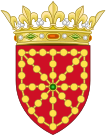Henry IV of France
| Henry IV | |||||
|---|---|---|---|---|---|
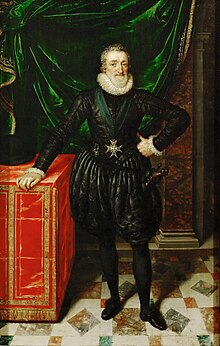 Portrait by Frans Pourbus the Younger, 1610 | |||||
| King of France (more...) | |||||
| Reign | 2 August 1589 – 14 May 1610 | ||||
| Coronation | 27 February 1594 Chartres Cathedral | ||||
| Predecessor | Henry III | ||||
| Successor | Louis XIII | ||||
| King of Navarre | |||||
| Reign | 9 June 1572 – 14 May 1610 | ||||
| Predecessor | Jeanne III | ||||
| Successor | Louis II | ||||
| Born | 13 December 1553 Pau, Kingdom of Navarre | ||||
| Died | 14 May 1610 (aged 56) Paris, Kingdom of France | ||||
| Burial | 1 July 1610 Basilica of St Denis, Paris, France | ||||
| Spouse | Margaret of Valois
(m. 1572; annulled 1599) | ||||
| Issue |
Illegitimate:
| ||||
| |||||
| House | Bourbon | ||||
| Father | Antoine of Navarre | ||||
| Mother | Jeanne III of Navarre | ||||
| Religion | Protestantism 1553-1595 Roman Catholicism 1595-1610 | ||||
| Signature |  | ||||
| Royal styles of King Henry IV Par la grâce de Dieu, Roi de France et de Navarre | |
|---|---|
 | |
| Reference style | His Most Christian Majesty |
| Spoken style | Your Most Christian Majesty |
| Alternative style | Sire |
Henry IV (French: Henri IV; 13 December 1553 – 14 May 1610), also known by the epithet Good King Henry or Henry the Great, was King of Navarre (as Henry III) from 1572 and King of France from 1589 to 1610. He was the first monarch of France from the House of Bourbon, a cadet branch of the Capetian dynasty. He was assassinated in 1610 by François Ravaillac, a fanatical Catholic, and was succeeded by his son Louis XIII.[1]
The son of Antoine de Bourbon, Duke of Vendôme and Jeanne d'Albret, the Queen of Navarre, Henry was baptised as a Catholic but raised in the Protestant faith by his mother. He inherited the throne of Navarre in 1572 on his mother's death. As a Huguenot, Henry was involved in the French Wars of Religion, barely escaping assassination in the St. Bartholomew's Day massacre. He later led Protestant forces against the royal army.[2]
He and his predecessor Henry III of France were direct descendants of Saint-King Louis IX. Henry III belonged to the House of Valois, descended from Philip III of France, elder son of Saint Louis; Henry IV belonged to the House of Bourbon, descended from Robert, Count of Clermont, younger son of Saint Louis. As Head of the House of Bourbon, Henry was "first prince of the blood". Upon the death of his brother-in-law and distant cousin Henry III in 1589, Henry was called to the French succession by the Salic law.
He initially kept the Protestant faith (the only French king to do so) and had to fight against the Catholic League, which denied that he could wear France's crown as a Protestant. After four years of stalemate, he converted to Catholicism to obtain mastery over his kingdom (reportedly saying, "Paris is well worth a mass."). As a pragmatic politician (in the parlance of the time, a politique), he displayed an unusual religious tolerance for the era. Notably, he promulgated the Edict of Nantes (1598), which guaranteed religious liberties to Protestants, thereby effectively ending the Wars of Religion.
Considered a usurper by some Catholics and a traitor by some Protestants, Henry became the target of at least 12 assassination attempts.[3] Having faced much opposition during his reign, Henry gained more status after his death.[4] He was admired for his repeated victories over his enemies and his conversion to Catholicism. "Good King Henry" (le bon roi Henri) was remembered for his geniality and his great concern about the welfare of his subjects.[2] An active ruler, he worked to regularise state finance, promote agriculture, eliminate corruption and encourage education. During his reign,[5] the French colonization of the Americas truly began with the foundation of the colonies of Acadia and Canada at Port-Royal and Quebec, respectively. He was celebrated in the popular song "Vive le roi Henri" (which later became an anthem for the French monarchy during the reigns of his successors) and in Voltaire's Henriade.
Early life
Childhood and adolescence

Henry de Bourbon was born in Pau, the capital of the joint Kingdom of Navarre with the sovereign principality of Béarn.[6] His parents were Queen Joan III of Navarre (Jeanne d'Albret) and her consort, Antoine de Bourbon, Duke of Vendôme, King of Navarre.[7] Although baptised as a Catholic, Henry was raised as a Protestant by his mother,[8] who had declared Calvinism the religion of Navarre. As a teenager, Henry joined the Huguenot forces in the French Wars of Religion. On 9 June 1572, upon his mother's death, the 19-year-old became King of Navarre.[9]
First marriage and Saint Bartholomew's Day Massacre
At Queen Joan's death, it was arranged for Henry to marry Margaret of Valois, daughter of Henry II of France and Catherine de' Medici. The wedding took place in Paris on 18 August 1572[10] on the parvis of Notre Dame Cathedral.
On 24 August, the St. Bartholomew's Day massacre began in Paris. Several thousand Protestants who had come to Paris for Henry's wedding were killed, as well as thousands more throughout the country in the days that followed. Henry narrowly escaped death thanks to the help of his wife and his promise to convert to Catholicism. He was forced to live at the court of France, but he escaped in early 1576. On 5 February of that year, he formally abjured Catholicism at Tours and rejoined the Protestant forces in the military conflict.[9] He named his 16-year-old sister, Catherine de Bourbon, regent of Béarn. Catherine held the regency for nearly thirty years.
Wars of Religion
Henry became heir presumptive to the French throne in 1584 upon the death of Francis, Duke of Anjou, brother and heir to the Catholic Henry III, who had succeeded Charles IX in 1574. Given that Henry of Navarre was the next senior agnatic descendant of King Louis IX, King Henry III had no choice but to recognise him as the legitimate successor.[11]
War of the Three Henrys (1587–1589)
- King Henry III of France, supported by the royalists and the politiques;
- King Henry of Navarre, heir presumptive to the French throne and leader of the Huguenots, supported by Elizabeth I of England and the Protestant princes of Germany; and
- Henry of Lorraine, Duke of Guise, leader of the Catholic League, funded and supported by Philip II of Spain.
Salic law barred the king's sisters and all others who could claim descent through only the female line from inheriting. Since Henry of Navarre was a Huguenot, the issue was not considered settled in many quarters of the country, and France was plunged into a phase of the Wars of Religion known as the War of the Three Henrys (1587–1589).
Henry I, Duke of Guise pushed for complete suppression of the Huguenots and had much support among Catholic loyalists. Political disagreements among the parties set off a series of campaigns and counter-campaigns that culminated in the Battle of Coutras.[12]
In December 1588, Henry III had Henry I of Guise murdered,[13] along with his brother, Louis, Cardinal de Guise.[14] Henry III thought the removal of the brothers would finally restore his authority. However, the populace was horrified and rose against him. The title of the king was no longer recognized in several cities; his power was limited to Blois, Tours, and the surrounding districts. In the general chaos, Henry III relied on King Henry of Navarre and his Huguenots.
The two kings were united by a common interest—to win France from the Catholic League. Henry III acknowledged the King of Navarre as a true subject and Frenchman, not a fanatic Huguenot aiming for the destruction of Catholics. Catholic royalist nobles also rallied to the king's standard. With this combined force, the two kings marched to Paris. The morale of the city was low, and even the Spanish ambassador believed the city could not hold out longer than a fortnight. But Henry III was assassinated shortly thereafter, on 2 August 1589, by a fanatical monk.[15]
Succession (1589–1594)


When Henry III died, Henry of Navarre nominally became king of France. The Catholic League, however, strengthened by support from outside the country—especially from Spain—was strong enough to prevent a universal recognition of his new title. The Pope excommunicated Henry and declared him devoid of any right to inherit the crown.[16] Most of the Catholic nobles who had joined Henry III for the siege of Paris also refused to recognize the claim of Henry of Navarre, and abandoned him. He set about winning his kingdom by military conquest, aided by English money and German troops. Henry's Catholic uncle Charles, Cardinal de Bourbon was proclaimed king by the League, but the Cardinal was Henry's prisoner at the time.[17] Henry was victorious at the Battle of Arques and the Battle of Ivry, but failed to take Paris after besieging it in 1590.[18]

When Cardinal de Bourbon died in 1590, the League could not agree on a new candidate. While some supported various Guise candidates, the strongest candidate was probably the Infanta Isabella Clara Eugenia of Spain, the daughter of Philip II of Spain, whose mother Elisabeth had been the eldest daughter of Henry II of France.[19] In the religious fervor of the time, the Infanta was recognized to be a suitable candidate, provided that she marry a suitable husband. The French overwhelmingly rejected Philip's first choice, Archduke Ernest of Austria, the Emperor's brother, also a member of the House of Habsburg. In case of such opposition, Philip indicated that princes of the House of Lorraine would be acceptable to him: the Duke of Guise; a son of the Duke of Lorraine; and the son of the Duke of Mayenne. The Spanish ambassadors selected the Duke of Guise, to the joy of the League. However, at that moment of seeming victory, the envy of the Duke of Mayenne was aroused, and he blocked the proposed election of a king.
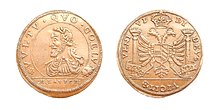
The Parlement of Paris also upheld the Salic law. They argued that if the French accepted natural hereditary succession, as proposed by the Spaniards, and accepted a woman as their queen, then the ancient claims of the English kings would be confirmed, and the monarchy of centuries past would be nothing but an illegality.[20] The Parlement admonished Mayenne, as lieutenant-general, that the kings of France had resisted the interference of the pope in political matters, and that he should not raise a foreign prince or princess to the throne of France under the pretext of religion. Mayenne was angered that he had not been consulted prior to this admonishment, but yielded, since their aim was not contrary to his present views.
Despite these setbacks for the League, Henry remained unable to take control of Paris.
Conversion to Catholicism: "Paris is well worth a Mass" (1593)

On 25 July 1593, with the encouragement of his great love, Gabrielle d'Estrées, Henry permanently renounced Protestantism and converted to Catholicism — in order to secure his hold on the French crown, thereby earning the resentment of the Huguenots and his former ally Queen Elizabeth I of England. He was said to have declared that Paris vaut bien une messe ("Paris is well worth a mass"),[21][22][23] although there is some doubt whether he said this, or whether the statement was attributed to him by his contemporaries.[24][25] His acceptance of Catholicism secured the allegiance of the vast majority of his subjects.
Coronation and recognition (1594–95)
Since Reims, traditional coronation place of French kings, was still occupied by the Catholic League, Henry was crowned King of France at the Cathedral of Chartres on 27 February 1594.[26] Pope Clement VIII lifted excommunication from Henry on 17 September 1595.[27] He did not forget his former Calvinist coreligionists, however, and was known for his religious tolerance. In 1598 he issued the Edict of Nantes, which granted circumscribed toleration to the Huguenots.[28]
Achievements of his reign
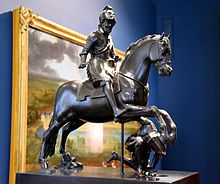
During his reign, Henry IV worked through his faithful right-hand man, the minister Maximilien de Béthune, Duke of Sully, to regularize state finance, promote agriculture, drain swamps, undertake public works, and encourage education. He established the Collège Royal Henri-le-Grand in La Flèche (today the Prytanée Militaire de la Flèche). He and Sully protected forests from further devastation, built a system of tree-lined highways, and constructed bridges and canals. He had a 1200-metre canal built in the park at the Château Fontainebleau (which may be fished today) and ordered the planting of pines, elms, and fruit trees.
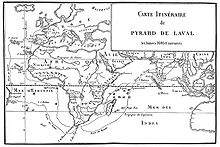
The King restored Paris as a great city, with the Pont Neuf, which still stands today, constructed over the river Seine to connect the Right and Left Banks of the city. Henry IV also had the Place Royale built (since 1800 known as Place des Vosges), and added the Grande Galerie to the Louvre Palace. More than 400 metres long and thirty-five metres wide, this huge addition was built along the bank of the Seine River. At the time it was the longest edifice of its kind in the world. King Henry IV, a promoter of the arts by all classes of people, invited hundreds of artists and craftsmen to live and work on the building's lower floors. This tradition continued for another two hundred years, until Emperor Napoleon I banned it. The art and architecture of his reign have become known as the "Henry IV style" since that time.
King Henry's vision extended beyond France, and he financed several expeditions of Pierre Dugua, Sieur de Monts and Samuel de Champlain[2] to North America. France laid claim to New France (now Canada).[29]
International relations under Henry IV

During the reign of Henry IV, rivalry continued among France, the Habsburg rulers of Spain, and the Holy Roman Empire for the mastery of Western Europe. The conflict was not resolved until after the Thirty Years' War.
Spain and Italy
During Henry's struggle for the crown, Spain had been the principal backer of the Catholic League, and it tried to thwart Henry. Under the Duke of Parma, an army from the Spanish Netherlands intervened in 1590 against Henry and foiled his siege of Paris. Another Spanish army helped the nobles opposing Henry to win the Battle of Craon against his troops in 1592.
After Henry's coronation, the war continued because there was an official tug-of-war between the French and Spanish states, but after victory at the Siege of Amiens in September 1597 the Peace of Vervins was signed in 1598. This enabled him to turn his attention to Savoy, with which he also had been fighting. Their conflicts were settled in the Treaty of Lyon of 1601, which mandated territorial exchanges between France and the Duchy of Savoy.
Germany
In 1609 Henry's intervention helped to settle the War of the Jülich Succession through diplomatic means.
It was widely believed that in 1610 Henry was preparing to go to war against the Holy Roman Empire. The preparations were terminated by his assassination, however, and the subsequent rapprochement with Spain under the regency of Marie de' Medici.
Ottoman Empire

Even before Henry's accession to the French throne, the French Huguenots were in contact with Aragonese Moriscos in plans against the Habsburg government of Spain in the 1570s.[31] Around 1575, plans were made for a combined attack of Aragonese Moriscos and Huguenots from Béarn under Henry against Spanish Aragon, in agreement with the king of Algiers and the Ottoman Empire, but this project floundered with the arrival of John of Austria in Aragon and the disarmament of the Moriscos.[32][33] In 1576, a three-pronged fleet from Constantinople was planned to disembark between Murcia and Valencia while the French Huguenots would invade from the north and the Moriscos accomplish their uprising, but the Ottoman fleet failed to arrive.[32] After his crowning, Henry continued the policy of a Franco-Ottoman alliance and received an embassy from Sultan Mehmed III in 1601.[34][35] In 1604, a "Peace Treaty and Capitulation" was signed between Henry IV and the Ottoman Sultan Ahmet I. It granted numerous advantages to France in the Ottoman Empire.[35]
In 1606–07, Henry IV sent Arnoult de Lisle as Ambassador to Morocco to obtain the observance of past friendship treaties. An embassy was sent to Tunisia in 1608 led by François Savary de Brèves.[36]
East Asia
During the reign of Henry IV, various enterprises were set up to develop trade with faraway lands. In December 1600, a company was formed through the association of Saint-Malo, Laval, and Vitré to trade with the Moluccas and Japan.[37] Two ships, the Croissant and the Corbin, were sent around the Cape of Good Hope in May 1601. The Corbin was wrecked in the Maldives, leading to the adventure of François Pyrard de Laval, who managed to return to France in 1611.[37][38] The Croissant, carrying François Martin de Vitré, reached Ceylon and traded with Aceh in Sumatra, but was captured by the Dutch on the return leg at Cape Finisterre.[37][38] François Martin de Vitré was the first Frenchman to write an account of travels to the Far East in 1604, at the request of Henry IV, and from that time numerous accounts on Asia would be published.[39]
From 1604 to 1609, following the return of François Martin de Vitré, Henry developed a strong enthusiasm for travel to Asia and attempted to set up a French East India Company on the model of England and the Netherlands.[38][39][40] On 1 June 1604, he issued letters patent to Dieppe merchants to form the Dieppe Company, giving them exclusive rights to Asian trade for 15 years. No ships were sent, however, until 1616.[37] In 1609, another adventurer, Pierre-Olivier Malherbe, returned from a circumnavigation of the globe and informed Henry of his adventures.[39] He had visited China and India, and had an encounter with Akbar.[39]
Character
This section needs additional citations for verification. (October 2014) |

Henry IV proved to be a man of vision and courage.[citation needed] Instead of waging costly wars to suppress opposing nobles, Henry simply paid them off. As king, he adopted policies and undertook projects to improve the lives of all subjects, which made him one of the country's most popular rulers ever.
Henry is said to have originated the oft-repeated phrase "a chicken in every pot".[2] The context for that phrase:
Si Dieu me prête vie, je ferai qu'il n'y aura point de laboureur en mon royaume qui n'ait les moyens d'avoir le dimanche une poule dans son pot |
If God grants me life, I will make it so that no plowman in my realm will lack the means to have a chicken in his pot on Sunday! |
This statement epitomises the peace and relative prosperity which Henry brought to France after decades of religious war, and demonstrates how well he understood the plight of the French worker and peasant farmer. This real concern for the living conditions of the "lowly" population—who in the final analysis provided the economic basis for the power of the king and the great nobles—was perhaps without parallel among the kings of France. Following his death Henry would be remembered fondly by most of the population.
Henry's forthright manner, physical courage, and military successes also contrasted dramatically with the sickly, effete languor of the last Valois kings, as evinced by his blunt assertion that he ruled with "weapon in hand and arse in the saddle" (on a le bras armé et le cul sur la selle). He was also a great philanderer, fathering many children by a number of mistresses.[2]
Nicknames
Henry was nicknamed "the Great" (Henri le Grand), and in France is also called le bon roi Henri ("the good king Henry") or le vert galant ("The Green Gallant", for his numerous mistresses).[2][41] In English he is most often referred to as Henry of Navarre.
Assassination
Henry was the subject of numerous attempts on his life, including one by Pierre Barrière in August 1593[42] and Jean Châtel in December 1594.[43]
He was finally killed in Paris on 14 May 1610 by a Catholic fanatic, François Ravaillac, who stabbed him in the Rue de la Ferronnerie. Henry's coach was stopped by traffic congestion associated with the Queen's coronation ceremony, as depicted in the engraving by Gaspar Bouttats.[44][45] Hercule de Rohan, duc de Montbazon, was with him when he was killed; Montbazon was wounded, but survived. Henry was buried at the Saint Denis Basilica.
His widow, Marie de' Medici, served as regent for their nine-year-old son, Louis XIII, until 1617.[46]
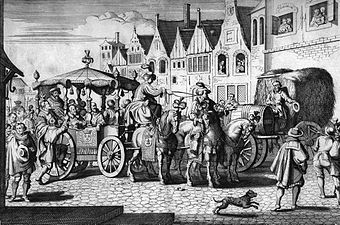
Assassination of Henry IV,
engraving by Gaspar Bouttats
His assassin, François Ravaillac, brandishing his dagger
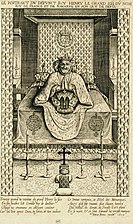
Pierre Firens - "Le Roi Est Mort continues at the Palace of Versailles". 1610

Lying in state at the Louvre, engraving after François Quesnel
Legacy
This section needs additional citations for verification. (February 2013) |

The reign of Henry IV was long remembered by the French people. A statue was erected in his honour at the Pont Neuf in 1614, four years after his death. During the earlier phase of the French Revolution, when its professed aim was to create a constitutional monarchy rather than a Republic, Henry IV was held up as an ideal which King Louis XVI was urged to emulate. When the Revolution radicalized its positions and came to altogether reject Monarchy, Henry IV's statue was torn down along with other royal monuments — but it was the first to be rebuilt, in 1818, and it stands today on the Pont Neuf.
A cult surrounding the personality of Henry IV emerged during the Bourbon Restoration. The restored Bourbons were keen to play down the controversial reigns of Louis XV and Louis XVI, and instead lauded the reign of the benevolent Henry IV. The song Marche Henri IV ("Long Live Henry IV") was popular during the Restoration. In addition, when Princess Caroline of Naples and Sicily (a descendant of his) gave birth to a male heir to the throne of France seven months after the assassination of her husband Charles Ferdinand, Duke of Berry, by a Republican fanatic, the boy was conspicuously named Henri in reference to his forefather Henry IV. The boy was also baptised in the traditional way of Béarn/Navarre, with a spoon of Jurançon wine and some garlic, imitating the quaint manner in which Henry IV had been baptised in Pau.
Henry served loosely as inspiration for the character of Ferdinand, King of Navarre in William Shakespeare's Love's Labour's Lost, sometime in the 1590's.[47]
Henry IV's popularity continued when the first edition of his biography, Histoire du Roy Henry le Grand, was published in Amsterdam in 1661. It was written by Hardouin de Péréfixe de Beaumont, successively bishop of Rhodez and archbishop of Paris, primarily for the edification of Louis XIV, grandson of Henry IV. A translation into English was made by James Dauncey for another grandson, King Charles II of England. An English edition was published at London in 1663.
On September 14, 1788, when anti-tax riots broke out during the insipient French Revolution, rioters demanded from those travelling through money for fireworks, and anyone riding in a carriage was forced to dismount to salute Henry IV.[48]
Genealogy
Ancestry
Patrilineal descent
| hidePatrilineal descent |
|---|
|
Henry's patriline was his line of descent in the male line, that is, from father to son only. Patrilineal descent governs membership and succession in many royal and noble houses. Henry was a scion of the House of Bourbon, which was a branch of the Capetian dynasty, which sprang from the Robertians. Henry's patriline ran through the house of Bourbon-Vendôme (Counts and then Dukes of Vendôme), descended from a younger son of the Count of Marche, descended from a younger son of the Duke of Bourbon, whose father was a younger son of Louis IX. Louis was the direct descendant of Hugh Capet, who became King of France in 987 and made the crown hereditary. Hugh was the heir of the "Robertian" house, Counts of Worms, descended from Robert of Hesbaye. This line has continued to the present day, more than 1,200 years in all, through kings of France, Navarre, France again, Spain, Portugal, and the Two Sicilies, dukes of Parma, grand dukes of Luxembourg, princes of Orléans, and emperors of Brazil. It is one of the oldest royal patrilines in Europe.
|
Religion
Historians have made the assertion that Henry IV was a convinced Calvinist, only changing his formal religious allegiance to adjust, suit or achieve his political goals.
Henry IV was baptized a Catholic on 5 January 1554. He was raised Reformed by his mother Jeanne III of Navarre. In 1572, after the massacre of French Calvinists, he was forced by Catherine de' Medici and other powerful Catholic royalty to convert. In 1576, as he managed to escape from Paris, he abjured Catholicism and returned to Calvinism. In 1593, in order to gain recognition as King of France, he converted again to Catholicism. Although a formal Catholic, he valued his Calvinist upbringing and was tolerant toward the Huguenots until his death in 1610, and issued the Edict of Nantes which granted many concessions to them.
Marriages and legitimate children
On 18 August 1572, Henry married his second cousin Margaret of Valois; their childless marriage was annulled in 1599. His subsequent marriage to Marie de' Medici on 17 December 1600 produced six children:
| Name | Birth | Death | Notes |
|---|---|---|---|
| Louis XIII, King of France | 27 September 1601 | 14 May 1643 | Married Anne of Austria in 1615 |
| Elisabeth, Queen of Spain | 22 November 1602 | 6 October 1644 | Married Philip IV, King of Spain, in 1615 |
| Christine Marie, Duchess of Savoy | 10 February 1606 | 27 December 1663 | Married Victor Amadeus I, Duke of Savoy, in 1619 |
| Nicolas Henri, Duke of Orléans | 16 April 1607 | 17 November 1611 | |
| Gaston, Duke of Orléans | 25 April 1608 | 2 February 1660 | Married (1) Marie de Bourbon, Duchess of Montpensier, in 1626 Married (2) Marguerite of Lorraine in 1632 |
| Henrietta Maria, Queen of England, Queen of Scots, and Queen of Ireland | 25 November 1609 | 10 September 1669 | Married Charles I, King of England, King of Scots and King of Ireland, in 1625 |
Second marriage
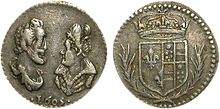
Henry's first marriage was not a happy one, and the couple remained childless. Henry and Margaret separated even before Henry acceded to the throne in August 1589; Margaret retired to the Château d'Usson in the Auvergne and lived there for many years. After Henry became king of France, it was of the utmost importance that he provide an heir to the crown to avoid the problem of a disputed succession.
Henry favoured the idea of obtaining an annulment of his marriage to Margaret and taking his mistress Gabrielle d'Estrées as his bride; after all, she had already borne him three children. Henry's councillors strongly opposed this idea, but the matter was resolved unexpectedly by Gabrielle's sudden death in the early hours of 10 April 1599, after she had given birth to a premature and stillborn son. His marriage to Margaret was annulled in 1599, and Henry married Marie de' Medici, daughter of Francesco I de' Medici, Grand Duke of Tuscany, and Archduchess Joanna of Austria, in 1600.[50]
For the royal entry of Marie into Avignon on 19 November 1600, the citizens bestowed on Henry the title of the Hercule Gaulois ("Gallic Hercules"), justifying the extravagant flattery with a genealogy that traced the origin of the House of Navarre to a nephew of Hercules' son .[51]
Armorial
The arms of Henry IV changed throughout his lifetime:

From 1562,
as Prince of Béarn and Duke of Vendôme
From 1572,
as King of Navarre
From 1589,
as King of France and Navarre (also used by his successors)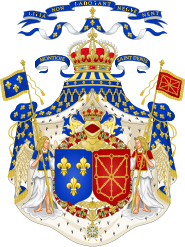
Grand Royal Coat of Arms of Henry and the House of Bourbon as Kings of France and Navarre (1589-1789)
Notes
- ^ Baird, Henry Martyn (1886). The Huguenots and Henry of Navarre. p. 486. ISBN 9780404005405.
- ^ Jump up to: a b c d e f Harris, Carolyn (August 2017). "The Queen's land". Canada's History. 97 (4): 34–43. ISSN 1920-9894.
- ^ Pierre Miquel, Les Guerres de religion, Paris, Club France Loisirs (1980) ISBN 2-7242-0785-8, p. 399
- ^ Le Figaro, "Henri IV, Dès sa mort, il entre dans la légende", 1 August 2009 [1]
- ^ Acadia. Encyclopedia Britannica
- ^ de La Croix, René, Duc de Castries, The Lives of the Kings and Queens of France, (Alfred A. Knopf:New York, 1979), p. 175
- ^ Henri IV Bourbon, Who's Who in Europe 1450 1750, ed. Henry Kamen, (Routledge, 2002), p. 145
- ^ Jump up to: a b Trevor N. Dupuy, Curt Johnson and David L. Bongard, Harper Encyclopedia of Military Biography, (Castle Books, 1995), p. 326
- ^ R.J. Knecht, Catherine de' Medici, (Longman, 1999), p. 153
- ^ Baird, Henry M., The Huguenots and Henry of Navarre, Vol. 1, (Charles Scribner's Sons:New York, 1886), p. 269
- ^ Baird, Vol 1, p. 431
- ^ Baird, Vol 2, p. 96
- ^ Baird, Vol 2, p. 103
- ^ Baird, Vol. 2, [2] pp. 156–157
- ^ Ritter, Raymond; Tapié, Victor-Lucien. "Henry IV, King of France". Encyclopedia Britannica. Retrieved 19 August 2018.
- ^ Baird, Vol. 2, [3] p. 180
- ^ Baird, Vol. 2, p. 181
- ^ Holt, Mack P., The French Wars of Religion, 1562–2011, (Cambridge University Press, 1995), p. 148
- ^ Ranke, Leopold. Civil Wars and Monarchy in France, p. 467
- ^ Alistair Horne, Seven Ages of Paris, Random House (2004)
- ^ F.P.G. Guizot (1787–1874) A Popular History of France..., gutenberg.org
- ^ Janel Mueller & Joshua Scodel, eds, Elizabeth I, University of Chicago Press (2009)
- ^ G. de Berthier de Savigny in his Histoire de France (1977 p. 167) claims that the Calvinists in revenge attributed the phrase to him.
- ^ Paul Desalmand & Yves Stallini, Petit Inventaire des Citations Malmenées (2009)[page needed]
- ^ Robert J. Knecht, The French Civil Wars, (Pearson Education Limited, 2000), p. 269
- ^ R. J. Knecht, The French Civil Wars, 1562–1598, (Routledge, 2013), 270.
- ^ de La Croix, pp. 179–180
- ^ de La Croix, p. 182
- ^ Bosworth, Clifford Edmund (1 January 1989). The Encyclopaedia of Islam: Fascicules 111–112: Masrah Mawlid. p. 799. ISBN 9789004092396. Retrieved 19 December 2010.
- ^ Kaplan, Benjamin J; Emerson, Michael O (2007). Divided by Faith. p. 311. ISBN 9780674024304. Retrieved 19 December 2010.
- ^ Jump up to: a b Lea, Henry Charles (January 1999). The Moriscos of Spain: Their Conversion and Expulsion. p. 281. ISBN 9780543959713.
- ^ L.P. Harvey (15 September 2008). Muslims in Spain, 1500 to 1614. p. 343. ISBN 9780226319650. Retrieved 19 December 2010.
- ^ Gocek, Fatma Muge (3 December 1987). East Encounters West: France and the Ottoman Empire in the Eighteenth Century. p. 9. ISBN 9780195364330.
- ^ Jump up to: a b Ziegler, Karl-Heinz (2004). "The peace treaties of the Ottoman Empire with European Christian powers". In Lesaffer, Randall (ed.). Peace Treaties and International Law in European History: From the Late Middle Ages to World War One. Cambridge University Press. p. 343. ISBN 978-0-521-82724-9.
- ^ Moalla, Asma (27 November 2003). The Regency of Tunis and the Ottoman Porte, 1777-1814: Army and Government of a North-African Eyâlet at the End of the Eighteenth Century. p. 59. ISBN 9780203987223.
- ^ Jump up to: a b c d Asia in the Making of Europe, Volume III: A Century of Advance. Book 1, Donald F. Lach pp. 93–94 [4]
- ^ Jump up to: a b c Newton, Arthur Percival (1936). The Cambridge History of the British Empire, volume 2. p. 61. Retrieved 19 December 2010.
- ^ Jump up to: a b c d Lach, Donald F; Van Kley, Edwin J (15 December 1998). Asia in the Making of Europe. p. 393. ISBN 9780226467658. Retrieved 19 December 2010.
- ^ A history of modern India, 1480–1950, Claude Markovits p. 144: The account of the experiences of François Martin de Vitré "incited the king to create a company in the image of that of the United Provinces"
- ^ l'Académie française: Dictionnaire de la langue française (Institut de France. 6th edition. 1835): 'C'est un vert galant' se dit d'un homme vif, alerte, qui aime beaucoup les femmes et qui s'empresse à leur plaire. É.Littré: Dictionnaire Française (Hachette. 1863): Hommme vif, alerte, vigoreux et particulièrement empressé auprès de femmes. Grand Larousse de la Langue Française (Paris. 1973): Homme entreprenant auprès de femmes. And see Discussion under the heading Vert Galant – A look at the Dictionaries
- ^ Baird, Vol. 2, p. 367
- ^ Baird, Vol. 2, p. 368
- ^ Pierre de l'Estoile, Journal du règne de Henri IV. Paris: Gallimard (1960), p. 84
- ^ Knecht, Robert J. The Murder of le roi Henri, History Today. May 2010 issue.
- ^ Moote, A. Lloyd, Louis XIII, the Just, (University of California Press, Ltd., 1989), p. 41
- ^ (editor), Love's Labour's Lost (Oxford University Press, 1990), p. 49
- ^ Peter Kropotkin (1909). "Chapter 5". The Great French Revolution, 1789-1793. Translated by N. F. Dryhurst. New York: Vanguard Printings.
Three weeks later, September 14, 1788, when the retirement of Lamoignon became known, the riotings were renewed. The mob rushed to set fire to the houses of the two ministers, Lamoignon and Brienne, as well as to that of Dubois. The troops were called out, and in the Rue Mélée and the Rue de Grenelle there was a horrible slaughter of poor folk who could not defend themselves. Dubois fled from Paris. "The people themselves would execute justice," said Les deux amis de la liberté. Later still, in October 1788, when the parlement that had been banished to Troyes was recalled, "the clerks and the populace" illuminated the Place Dauphine for several evenings in succession. They demanded money from the passersby to expend on fireworks, and forced gentlemen to alight from their carriages to salute the statue of Henri Quatre.
- ^ Neil D. Thompson and Charles M. Hansen, The Ancestry of Charles II, King of England (American Society of Genealogists, 2012).
- ^ Vincent J. Pitts, Henri IV of France, his Reign and Age, (The Johns Hopkins University Press, 2009), 229.
- ^ The official account, Labyrinthe royal... quoted in Jean Seznec, The Survival of the Pagan Gods, (B.F. Sessions, tr., 1995) p. 26
References
- Baird, Henry M. (1886). The Huguenots and Henry of Navarre (2 volumes). New York: Charles Scribner's Sons. Vol. 2 (copies [5] 1 & [6] 2) at Google Books.
- Baumgartner, Frederic J. (1995). France in the Sixteenth Century. London: Macmillan. ISBN 978-0-333-62088-5.
- de La Croix, Rene; de Castries, Duc (1979). The Lives of the Kings & Queens of France. New York: Alfred A. Knopf. ISBN 978-0-394-50734-7.
- Dupuy, Trevor N.; Johnson, Curt & Bongard, David L. (1995). The Harper Encyclopedia of Military Biography. Castle Books. ISBN 978-0-7858-0437-6.
- Holt, Mack P. (2005). The French Wars of Religion, 1562–1629. Cambridge: Cambridge University Press. ISBN 978-0-521-83872-6.
- Knecht, R.J. (1998). Catherine de' Medici. London; New York: Longman. ISBN 978-0-582-08241-0.
- ——— (2002). The French Religious Wars, 1562–1598. Oxford: Osprey. ISBN 978-1-84176-395-8.
- ——— (2001). The Rise and Fall of Renaissance France, 1483–1610. Oxford: Blackwell. ISBN 978-0-631-22729-8.
- (2010). A 400 anni dai Trattati di Bruzolo. Gli equilibri europei prima e dopo i Trattati. Susa: Segusium (association).
- Moote, A. Lloyd (1991). Louis XIII, the Just. Berkeley: University of California Press. ISBN 978-0-520-07546-7.
- Urzainqui, Tomas; Esarte, Pello; García Manzanal, Alberto; Sagredo, Iñaki; Sagredo, Iñaki; Del Castillo, Eneko; Monjo, Emilio; Ruiz de Pablos, Francisco; Guerra Viscarret, Pello; Lartiga, Halip; Lavin, Josu; Ercilla, Manuel (2013). La Conquista de Navarra y la Reforma Europea. Pamplona-Iruña: Pamiela. ISBN 978-84-7681-803-9.
Further reading
- Non-fiction
- Baumgartner, Frederic J. (1995). France in the Sixteenth Century. London: Macmillan. ISBN 978-0-333-62088-5.
- Briggs, Robin (1977). Early Modern France, 1560–1715. Oxford: Oxford University Press. ISBN 978-0-19-289040-5.
- Bryson, David M. (1999). Queen Jeanne and the Promised Land: Dynasty, Homeland, Religion and Violence in Sixteenth-century France. Leiden; Boston, MA: Brill Academic. ISBN 978-90-04-11378-7.
- Buisseret, David (1990). Henry IV, King of France. New York: Routledge. ISBN 978-0-04-445635-3.
- Cameron, Keith, ed. (1989). From Valois to Bourbon: Dynasty, State & Society in Early Modern France. Exeter: University of Exeter. ISBN 978-0-85989-310-7.
- Finley-Croswhite, S. Annette (1999). Henry IV and the Towns: The Pursuit of Legitimacy in French Urban Society, 1589–1610. Cambridge: Cambridge University Press. ISBN 978-0-521-62017-8.
- Frieda, Leonie (2005). Catherine de Medici. London: Phoenix. ISBN 978-0-7538-2039-1.
- Greengrass, Mark (1984). France in the Age of Henri IV: The Struggle for Stability. London: Longman. ISBN 978-0-582-49251-6.
- Holt, Mack P. (2005). The French Wars of Religion, 1562–1629. Cambridge: Cambridge University Press. ISBN 978-0-521-83872-6.
- Lee, Maurice J. (1970). James I & Henri IV: An Essay in English Foreign Policy, 1603–1610. Urbana: University of Illinois Press. ISBN 978-0-252-00084-3.
- Lloyd, Howell A. (1983). The State, France, and the Sixteenth Century. London: George Allen and Unwin. ISBN 978-0-04-940066-5.
- Lockyer, Roger (1974). Habsburg and Bourbon Europe, 1470–1720. Harlow, UK: Longman. ISBN 978-0-582-35029-8.
- Love, Ronald S. (2001). Blood and Religion: The Conscience of Henri IV, 1553–1593. Montreal: McGill-Queen's University Press. ISBN 978-0-7735-2124-7.
- Major, J. Russell (1997). From Renaissance Monarchy to Absolute Monarchy: French Kings, Nobles & Estates. Baltimore: Johns Hopkins University Press. ISBN 978-0-8018-5631-0.
- Mousnier, Roland (1973). The Assassination of Henry IV: The Tyrannicide Problem and the Consolidation of the French Absolute Monarchy in the Early Seventeenth Century. Translated by Joan Spencer. London: Faber & Faber. ISBN 978-0-684-13357-7.
- Pettegree, Andrew (2002). Europe in the Sixteenth Century. Oxford: Blackwell. ISBN 978-0-631-20704-7.
- Pitts, Vincent J. (2009). Henri IV of France: His Reign and Age. Baltimore: Johns Hopkins University Press. ISBN 978-0-8018-9027-7.
- Salmon, J.H.M. (1975). Society in Crisis: France in the Sixteenth Century. London: Ernest Benn. ISBN 978-0-510-26351-5.
- Sutherland, N.M. (1973). The Massacre of St. Bartholomew and the European Conflict, 1559–1572. London: Macmillan. ISBN 978-0-333-13629-4.
- ——— (1980). The Huguenot Struggle for Recognition. New Haven: Yale University Press. ISBN 978-0-300-02328-2.
- ——— (1984). Princes, Politics and Religion, 1547–1589. London: Hambledon Press. ISBN 978-0-907628-44-6.
- ——— (2002). Henry IV of France and the Politics of Religion, 1572–1596. 2 volumes. Bristol: Elm Bank. ISBN 978-1-84150-846-7.
- Wolfe, Michael (1993). The Conversion of Henri IV: Politics, Power, and Religious Belief in Early Modern France. Cambridge, MA: Harvard University Press. ISBN 0-674-17031-8
- Fiction
- George Chapman (1559?–1634), The Conspiracy and Tragedy of Charles, Duke of Byron (1608), éd. John Margeson (Manchester: Manchester University Press, 1988)
- Alexandre Dumas, La Reine Margot (Queen Margot) (1845)
- Heinrich Mann, Die Jugend des Königs Henry Quatre (1935); Die Vollendung des Königs Henry Quatre (1938) (in German)
- M. de Rozoy, Henri IV, Drame lyrique (1774) (in French)
External links
 Henri IV. to the Fair Gabrielle., a poem by Letitia Elizabeth Landon adjoined to a painting Henri IV and Gabrielle d'Estrées by Richard Westall.
Henri IV. to the Fair Gabrielle., a poem by Letitia Elizabeth Landon adjoined to a painting Henri IV and Gabrielle d'Estrées by Richard Westall.
| Wikiquote has quotations related to: Henry IV of France |
| Wikimedia Commons has media related to Henry IV of France. |
- Henri IV – An unfinished reign Official website published by the French Ministry of Culture
- Henry IV of France
- 1553 births
- 1610 deaths
- 16th-century kings of France
- 17th-century kings of France
- 16th-century Princes of Andorra
- 17th-century Princes of Andorra
- 16th-century Navarrese monarchs
- 17th-century Navarrese monarchs
- Ancien Régime in France
- Assassinated French people
- Assassinated royalty
- 1610 crimes
- Burials at the Basilica of Saint-Denis
- Converts to Roman Catholicism from Calvinism
- Counts of Armagnac
- Counts of Foix
- Deaths by stabbing in France
- Dukes of Vendôme
- French Calvinist and Reformed Christians
- French Roman Catholics
- Heirs presumptive to the French throne
- House of Bourbon
- Knights of the Garter
- Navarrese infantes
- Navarrese monarchs
- Nostradamus
- Occitan people
- People temporarily excommunicated by the Catholic Church
- People from Pau, Pyrénées-Atlantiques
- People murdered in Paris
- French people of the French Wars of Religion
- Princes of Andorra
- 17th-century murdered monarchs
- 16th-century peers of France
- 17th-century peers of France
- 16th-century people from the Kingdom of Navarre









